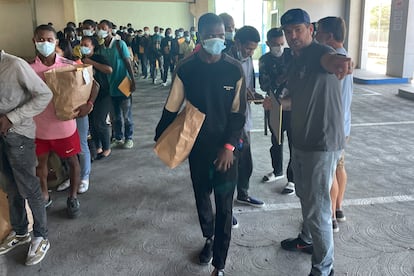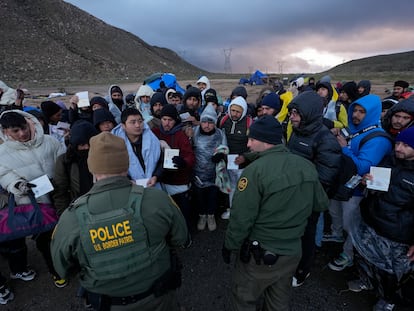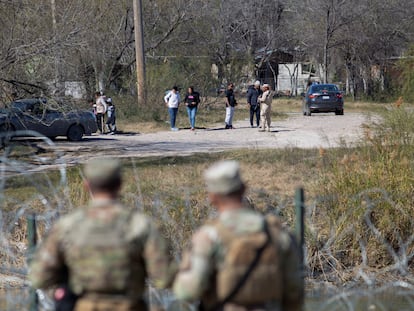Border Patrol releases hundreds of migrants at a bus stop after San Diego runs out of aid money
Migrants who previously had a safe place to charge phones, use the bathroom, eat a meal and arrange to head elsewhere in the U.S. were now left on the street as migrant aid groups scrambled to help out as best they could

Hundreds of migrants were dropped off Friday at a San Diego bus stop instead of at a reception center that had been serving as a staging area because it ran out of local funding sooner than expected, showing how even the largest city on the country’s southern border is struggling to cope with the unprecedented influx of people.
Migrants who previously had a safe place to charge phones, use the bathroom, eat a meal and arrange to head elsewhere in the U.S. were now left on the street as migrant aid groups scrambled to help out as best they could with makeshift arrangements.
Border Patrol buses carrying migrants from Senegal, China, Ecuador, Guatemala and many other countries arrived outside a transit center. Migrant aid groups said they would be bused from there to a parking lot where they could charge their phones and get a ride to the airport. The vast majority planned to spend only a few hours in San Diego before taking a flight or having someone pick them up.
“Are we in San Diego?” asked Gabriel Guzman, 30, a painter from the Dominican Republic who was released after crossing the border in remote mountains on Thursday. He was told to appear in June in an immigration court in Boston, where he hopes to earn money to send home to his three children.
Abd Boudeah, of Mauritania, flew to Tijuana, Mexico, through Nicaragua and followed other migrants to an opening in the border wall, where he surrendered to agents Thursday after walking about eight hours. The former molecular engineering student said he fled persecution for being gay and planned to settle in Chicago with a cousin who had been in the U.S. for 20 years.
“I’ve dreamed about this (moment) a lot, and thank God I’m here,” Boudeah, 23, said in flawless English.
Volunteers gave instructions in English, Spanish and French to small groups, all of them single men and women. They used translation apps for other languages.
“We’re going to cross the street together and line up,” a volunteer said into his phone, which then translated it into Hindi for a group of men from India.
“Tired from the road,” Alikan Rdiyer, 31, of Kazakhstan, said in Russian as he waited for instructions to give to a friend from Los Angeles who was going to pick him up. The Border Patrol gave him a notice to appear in immigration court in August 2025 in Philadelphia — a city he hadn’t heard of.
The transit center parking lot was full of cars, giving migrants nowhere to stand, and there were no public bathrooms. A taxi driver offered a ride to San Diego International Airport for $100, double what ride-sharing apps were charging. Some migrants dispersed in the neighborhood when volunteers were unable to reach them with instructions to wait on the sidewalk.
San Diego County has given $6 million since October to SBCS, a nonprofit formerly known as South Bay Community Services, to provide phone-charging stations, food, travel advice and other services at a former elementary school. The group aimed to keep it open through March, but Thursday was its last day.
San Diego is one of many local governments that have struggled to help migrants without sacrificing key services, including New York, Chicago and Denver. Like other border cities, migrants tend to stay in San Diego less than a day before moving on, but large shelters operated by Jewish Family Service and Catholic Charities have been full for months, giving priority to families.
Nora Vargas, chair of the San Diego County board of supervisors, steadfastly supported the migrant welcome center but said the county had to pause spending as it assesses damages from catastrophic January flooding and addresses homelessness and lack of health care among its residents. “We have to be financially prudent about it,” she said.
SBCS, which has come under withering criticism from some migrant advocacy groups, told the county that its services cost $1.4 million a month, said spokesperson Margie Newman Tsay. The county asked that it aim for $1 million.
“It’s not that funds ran out early, it’s that the funds were stretched as far as they could go,” Newman Tsay said.
SBCS said it had served 81,000 migrants since Oct. 11. A report to the county showed it spent $750,000 on personnel through Dec. 24 and $152,000 on operating expenses, including shelter, transportation and security.
“I could have done a lot more with $6 million,” said Erika Pinheiro, executive director of Al Otro Lado, a migrant aid group that is assisting with street releases.
Vargas, who wrote President Joe Biden last week seeking support, defended SBCS’s performance and noted its previous work sheltering unaccompanied child migrants at the San Diego Convention Center in 2019.
“Nobody is perfect, especially when you’re trying to fill a gap from the federal government,” said Vargas, echoing a common view among big-city mayors.
From October to January, the Border Patrol released more than 500,000 migrants with orders to appear in immigration court. Migrant aid groups are generally able to provide temporary shelter, but street releases are not unheard of. The San Diego transit center was also the scene of large-scale releases last year.
San Diego has emerged as one of the busiest corridors for illegal crossings, with an average of 800 arrests a day in January. Many are from West Africa and Asia, with a daily average of more than 100 from China in January.
The Border Patrol told migrant aid groups to expect 350 street releases on Friday, said Pedro Rios, director of American Friends Service Committee’s U.S.-Mexico border program. The Border Patrol had no immediate comment.
Sign up for our weekly newsletter to get more English-language news coverage from EL PAÍS USA Edition
Tu suscripción se está usando en otro dispositivo
¿Quieres añadir otro usuario a tu suscripción?
Si continúas leyendo en este dispositivo, no se podrá leer en el otro.
FlechaTu suscripción se está usando en otro dispositivo y solo puedes acceder a EL PAÍS desde un dispositivo a la vez.
Si quieres compartir tu cuenta, cambia tu suscripción a la modalidad Premium, así podrás añadir otro usuario. Cada uno accederá con su propia cuenta de email, lo que os permitirá personalizar vuestra experiencia en EL PAÍS.
¿Tienes una suscripción de empresa? Accede aquí para contratar más cuentas.
En el caso de no saber quién está usando tu cuenta, te recomendamos cambiar tu contraseña aquí.
Si decides continuar compartiendo tu cuenta, este mensaje se mostrará en tu dispositivo y en el de la otra persona que está usando tu cuenta de forma indefinida, afectando a tu experiencia de lectura. Puedes consultar aquí los términos y condiciones de la suscripción digital.
More information
Archived In
Últimas noticias
Welcome to the post-religion era: The idea of Christianity as the absolute truth has become obsolete
‘I thought you would like it’: The risky sexual practice popularized by TV shows and TikTok
The digitalization of tourism: ‘They promise experiences and gave us the worst possible one’
Mexican peso defies uncertainty with forecasts of a new period of stability in 2026
Most viewed
- Sinaloa Cartel war is taking its toll on Los Chapitos
- Oona Chaplin: ‘I told James Cameron that I was living in a treehouse and starting a permaculture project with a friend’
- Reinhard Genzel, Nobel laureate in physics: ‘One-minute videos will never give you the truth’
- Why the price of coffee has skyrocketed: from Brazilian plantations to specialty coffee houses
- Silver prices are going crazy: This is what’s fueling the rally










































